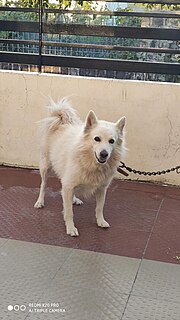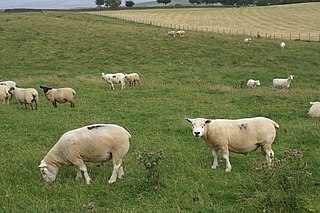Related Research Articles
The Dagliç is a breed of sheep found primarily in western Anatolia in Turkey. They are a carpet wool breed used for both meat and dairy production. Sheep of this breed typically have black spots on the head and legs, the rams are usually horned and the ewes are polled. The breed is thought by some to be the origin of the Chios and Kamakuyruk breeds.

The Indian Spitz is a spitz-type dog breed belonging to the utility group. The Indian Spitz was one of the most popular dogs in India in the 1980s and the 1990s when India's import rules made it very difficult to import dogs of other breeds.

The Basco-béarnaise is a domesticated breed of sheep originating in the Basque country. The breed was developed from Basque and Béarnaise sheep during the 1960s to be a single-purpose milk breed.

The Beltex is a breed of domestic sheep. A portmanteau of Belgian and Texel, the name reflects the breed's origin as an offshoot of Texel sheep from The Netherlands. In the late 1980s, Belgian Texels were exported to the United Kingdom, and it was there that it was primarily refined into its modern form. It is primarily used in Europe as a terminal sire, meaning Beltex rams are prized for mating with ewes to produce lambs for meat.
The Damani is a thin tail, meat and wool breed which is found in the Dera Ismail Khan district and part of Bannu district in Khyber Pakhtunkhwa province of Pakistan.
Alai is a breed of domesticated sheep found in Kyrgyzstan. This breed is a dual purpose breed raised for its meat and wool.
Altay is a breed of domesticated sheep originating in the dry, cold mountain basins of China. This breed belongs to the fat-rumped carpet wool type of sheep and the Kazakh group. Although the Altay grows wool, it is raised primarily for the meat.
Arabi is a domesticated breed of sheep from southwestern Iran, southern Iraq and northeastern Arabia and Egypt. Though it does grow wool, it is primarily raised for meat.

Algerian Arab sheep is a breed of domesticated sheep found throughout Algeria. This breed does grow a carpet-grade wool, and is raised primarily for meat.

Askanian is a breed of domesticated sheep found in Ukraine. It is a fine-wool breed bred for its wool. It was developed by crossing American Rambouillet with Merinos in the early 1900s.
The Balkhi is a domesticated breed of sheep found in Afghanistan and North-western Pakistan. This breed is of the fat-tailed mutton type. Though this breed does grow wool, it is primarily raised for meat.

The Bardoka or White Metohian sheep is a multi-purpose breed of domesticated sheep in Kosovo. It is a popular sheep in Kosovo and partially in Montenegro, Serbia and Albania. This breed appears to adaptable to all environmental conditions especially low temperatures. However, the Bardoka is sensitive to high humidity.

The Bentheimer Landschaf is a breed of domesticated sheep found in Germany. This breed is a cross between German and Dutch heath sheep and a marsh sheep. It is primarily used for landscape preservation.
The Bibrik is a fat tailed, domesticated breed of meat sheep that is found in Baluchistan Province of Pakistan.

The Bizet[bi.ze] is a domesticated breed of sheep originating from France. It grows wool but is primarily raised for meat. In 1952, the Bizet was introduced on the Kerguelen archipelago. It is utilized as food for the scientific station there.
The Bündner Oberländerschaf is a domesticated breed of sheep in Switzerland. As of 2007, there were less than 1,100 but the population is increasing and used primarily for vegetation management.

The Charmoise is a domesticated breed of sheep originating in France. The breed was developed in the middle 19th century in the center of France by crossing imported Romney sheep from United Kingdom to ewes from local breeds. There is a monument in Pontlevoy, central France, to creator of the breed, Édouard Malingié (1799-1852. The Charmoise is a meat breed. The population of this breed decreased from over 122,000 in 1993 to over 21,000 in 2001.
The Cholistani is a breed of domestic sheep from Pakistan. Though the Cholistani grows wool, it is raised primarily for meat.
The Cikta is a breed of domestic sheep from Hungary. In the 18th century, this breed was brought to Hungary by German settlers. This breed grows wool but is primarily raised for meat. The Cikta belong in the Mountain Group of sheep breeds.

The Coburger Fuchsschaf is a breed of domestic sheep from Germany. It is characterized by its reddish brown to golden color, which is most pronounced at birth, but remains at the head and the legs in the adult. Many animals also have a dorsal stripe.
References
- 1 2 3 "Algarve Churro". Breeds of Livestock. Oklahoma State University, Dept. of Animal Science. Archived from the original on 2008-11-04. Retrieved 2009-05-08.
- 1 2 3 "Churra Algarvia/Portugal". Breed data sheet. Domisticated Animal Diversity Information System. Retrieved 2009-05-08.